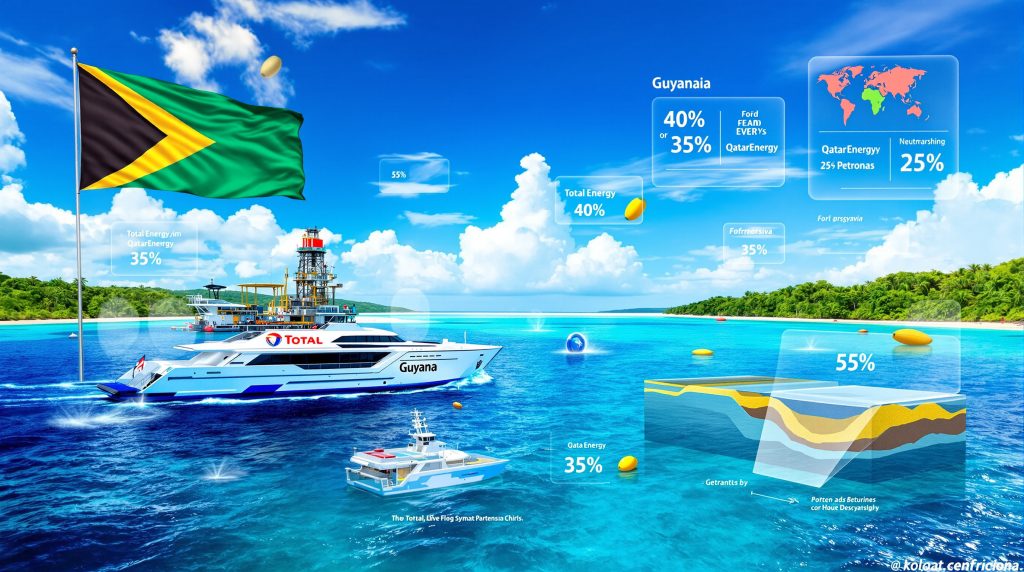Understanding TotalEnergies' Strategic Partnership in Guyana Waters
The TotalEnergies Guyana offshore exploration initiative has secured a significant foothold in Guyana's prolific offshore energy sector through its newly awarded Block S4 production sharing contract. This strategic partnership positions the French energy giant as operator alongside QatarEnergy and Petronas, marking a pivotal expansion into one of the world's most active exploration frontiers. Furthermore, this development reflects growing international interest in the region's hydrocarbon potential.
The partnership structure reflects careful strategic alignment among three major international energy companies. TotalEnergies holds the largest stake at 40% while maintaining operational control, QatarEnergy contributes 35% ownership, and Malaysia's Petronas rounds out the consortium with 25%. This distribution balances operational expertise with financial capacity and regional knowledge.
The production sharing contract framework governing Block S4 follows Guyana's established petroleum regulatory structure, which has proven attractive to international investors. Under typical Guyanese PSC terms, the government retains ownership of petroleum resources while contracting operators to conduct exploration and development activities. Revenue sharing mechanisms typically include cost recovery provisions, profit sharing arrangements, and corporate tax obligations that can result in government take rates exceeding 50% for profitable projects.
Minister Vickram Bharrat of Guyana's Ministry of Natural Resources formalised the agreement, which emerged from the country's competitive 2022 Licensing Round. This licensing process has systematically opened Guyana's offshore acreage to international exploration, following the massive success of earlier discoveries in the region. Consequently, this approach has attracted major international energy companies seeking to capitalise on proven hydrocarbon systems.
Comparing Block S4 to Guyana's Offshore Portfolio
Block S4 occupies a strategically advantageous position within Guyana's offshore geology. Located 50 to 100 kilometres from the coastline, the 1,788 square kilometre block sits in shallow waters that offer operational advantages over deepwater alternatives. This positioning places it closer to shore than many of the region's major producing assets while maintaining access to proven hydrocarbon systems.
The Stabroek Block, operated by ExxonMobil in partnership with Hess and CNOOC, serves as the primary comparison point for Guyana's offshore potential. This massive 26,800 square kilometre concession extends 120 to 200 kilometres offshore in deepwater environments exceeding 1,000 metres depth. Since 2015, the Stabroek Block has yielded over 30 discoveries totalling more than 11 billion barrels of recoverable resources.
Comparative Analysis: Block S4 vs Stabroek
| Parameter | Block S4 | Stabroek Block |
|---|---|---|
| Distance from Shore | 50-100 km | 120-200 km |
| Water Depth | Shallow-water (<500m) | Deepwater (>1,000m) |
| Area Coverage | 1,788 km² | 26,800 km² |
| Current Status | Exploration phase | Production active |
| Operator | TotalEnergies | ExxonMobil |
The geological continuity between Block S4 and proven productive areas provides encouraging exploration potential. The Guyana-Suriname Basin's Cretaceous and Tertiary sedimentary sequences have demonstrated exceptional source rock quality and reservoir characteristics. Turbidite sand systems within this basin have created some of the highest-quality reservoirs discovered globally in recent decades.
Block S4's shallow-water positioning offers distinct operational advantages including reduced drilling costs, shorter development timelines, and enhanced safety profiles compared to deepwater alternatives. Typical shallow-water development costs range from $15-25 per barrel of reserves compared to $25-40 per barrel for deepwater projects, while development timelines can be compressed by 2-3 years.
Advanced Exploration Technologies for Shallow-Water Success
TotalEnergies plans to deploy cutting-edge seismic technology across Block S4 through a comprehensive 2,000 square kilometre 3D seismic survey. This extensive data acquisition program represents one of the most comprehensive shallow-water mapping initiatives undertaken in the region, utilising high-resolution imaging capabilities to identify subsurface hydrocarbon accumulations. Modern exploration now benefits from AI in drilling operations that enhance prospect identification accuracy.
Modern 3D seismic acquisition in shallow-water environments employs advanced multi-sensor technologies that capture detailed subsurface images with resolutions approaching 10-15 metres vertically. These systems utilise broadband seismic sources and sophisticated receiver arrays to penetrate complex geological structures while minimising environmental impact through reduced acoustic intensity.
The planned seismic survey will employ artificial intelligence-enhanced processing algorithms to accelerate interpretation workflows and improve prospect identification accuracy.
High-resolution seismic processing techniques now incorporate machine learning algorithms that can identify geological features with unprecedented precision. These AI-enhanced systems analyse massive datasets to recognise patterns associated with hydrocarbon accumulations, fault systems, and reservoir quality indicators that might escape traditional interpretation methods.
Environmental monitoring protocols during seismic operations include real-time marine mammal observation systems, seasonal timing restrictions to avoid breeding periods, and advanced acoustic mitigation technologies. These measures ensure compliance with international standards while maintaining operational efficiency.
Shallow-water drilling operations benefit from established infrastructure and reduced logistical complexity compared to deepwater projects. Water depths of 200-500 metres allow for conventional jackup rig operations, eliminating the need for sophisticated deepwater drilling vessels. This operational advantage translates to daily rates of $150,000-200,000 compared to $400,000-600,000 for sixth-generation deepwater rigs.
Strategic Significance for Global Energy Markets
The TotalEnergies Guyana offshore exploration partnership in Block S4 represents a significant expansion of international collaboration in Guyana's energy sector. This strategic alliance combines TotalEnergies' operational expertise in complex offshore projects with QatarEnergy's substantial financial resources and Petronas' regional technical capabilities. However, the venture takes place amid evolving oil market dynamics that influence global exploration investment decisions.
TotalEnergies brings extensive deepwater operational experience from projects across West Africa, North Sea, and Gulf of Mexico. The company has successfully operated over 50 offshore fields globally, with particular expertise in challenging technical environments. Their operational track record includes major deepwater developments in Angola, Nigeria, and Brazil, providing directly applicable experience for Guyana operations.
QatarEnergy contributes substantial financial capacity backed by Qatar's sovereign wealth resources exceeding $450 billion. This financial strength provides stability for long-term exploration programs that may require sustained investment over multiple drilling campaigns before achieving commercial success. In addition, their expertise in OPEC production insights offers valuable market perspective.
Petronas offers regional operational experience and established relationships within Latin American markets. The Malaysian national oil company has operated in over 20 countries globally and brings particular expertise in shallow-water development and LNG project execution.
The partnership's formation reflects broader trends in global energy supply diversification. European markets, in particular, have prioritised reducing dependence on traditional suppliers following geopolitical disruptions in 2022. Atlantic Basin production from Guyana offers strategic supply route advantages for European refineries seeking reliable crude oil sources. Furthermore, this aligns with the broader energy transition outlook as companies seek reliable hydrocarbon sources during the transition period.
Strategic Partnership Benefits:
• Technical Expertise Integration: Combining deepwater operational experience with shallow-water development capabilities
• Financial Risk Distribution: Spreading exploration costs across three major international energy companies
• Market Access Optimisation: Leveraging diverse global marketing networks for potential future production
• Technology Sharing: Cross-pollinating best practices from different operational environments
Environmental Framework for Responsible Development
Environmental considerations play a central role in Block S4's development planning, reflecting both regulatory requirements and corporate sustainability commitments. TotalEnergies has committed to pursuing low-emission resource development strategies that minimise carbon intensity throughout the exploration and potential production phases.
The shallow-water environment of Block S4 presents unique environmental advantages including reduced offshore infrastructure requirements and shorter transportation distances to shore-based facilities. These factors contribute to lower overall project emissions compared to remote deepwater developments requiring extensive subsea infrastructure.
Marine ecosystem protection protocols for Block S4 operations must comply with Guyana's Environmental Protection Act and associated regulations. These requirements include comprehensive environmental impact assessments, marine mammal protection measures during seismic operations, and strict discharge standards for drilling fluids and produced water.
Carbon footprint minimisation strategies during exploration focus on operational efficiency improvements and technology optimisation. Modern shallow-water rigs incorporate advanced power management systems that can reduce fuel consumption by 20-30% compared to older generation equipment. Additionally, shore-based power connections where feasible can eliminate diesel generator emissions during drilling operations.
Environmental monitoring systems will provide real-time data on marine conditions, ensuring compliance with international best practices for offshore petroleum operations.
Waste management protocols follow international standards for offshore drilling operations, including zero-discharge policies for synthetic drilling fluids and comprehensive recycling programs for steel casing and equipment. Environmental bonds typically required for Guyanese offshore operations range from $10-20 million to ensure adequate funding for environmental remediation if required.
Community engagement programs in coastal Guyanese communities emphasise local employment opportunities and skills development initiatives. Typical local content requirements in Guyana mandate that 10-20% of project expenditures support local businesses and workforce development, with higher percentages required as projects mature.
Economic Impact Projections for Guyana
Block S4's economic impact on Guyana could prove substantial if exploration efforts yield commercial discoveries. The exploration phase alone represents an estimated investment of $200-300 million over the initial three-year work program, providing immediate economic benefits through local procurement and employment. These developments require careful consideration of investment strategy insights to maximise returns for all stakeholders.
Projected Economic Benefits Timeline:
| Phase | Investment Range | Timeline | Local Impact |
|---|---|---|---|
| Exploration | $200-300 million | 2025-2027 | 300-500 jobs |
| Appraisal | $400-600 million | 2027-2029 | 600-800 jobs |
| Development | $2-4 billion | 2029-2032 | 2,000-3,000 jobs |
| Production | $100-200 million annually | 2032+ | 1,500-2,500 jobs |
Government revenue from Block S4 will flow through multiple channels including signature bonuses, annual surface rentals, royalty payments, and corporate income taxes. Under Guyana's petroleum fiscal regime, the government typically receives 2% royalty on gross production plus 50% of profit oil after cost recovery. Corporate tax rates of 25-40% apply to petroleum company profits.
Infrastructure development requirements for Block S4 operations include port facility upgrades, helicopter service bases, and supply vessel support facilities. The Georgetown Port expansion project, partially funded by petroleum revenue, will enhance the country's capacity to support multiple offshore operations simultaneously.
Local content development opportunities span equipment procurement, catering services, transportation, and professional services. Guyanese contractors have successfully captured increasing shares of offshore support services, with local participation rates growing from less than 5% in early Stabroek operations to over 25% in recent development phases.
The multiplier effects of offshore petroleum development extend throughout Guyana's economy, supporting services sectors, construction, and consumer goods industries. Economic modelling suggests that each dollar of petroleum investment generates $1.50-2.00 in total economic activity through supply chain linkages and consumer spending.
What Are the Primary Risk Factors for Block S4?
Block S4 exploration faces several technical and commercial risk factors that could influence project outcomes. Geological uncertainty remains the primary exploration risk, despite the block's location within a proven hydrocarbon basin. Shallow-water areas have received less exploration attention than deepwater zones, creating higher uncertainty about reservoir presence and quality.
Primary Risk Categories:
• Geological Risk: Uncertainty in reservoir presence, quality, and commercial viability
• Technical Risk: Drilling and completion challenges in shallow-water carbonate sequences
• Commercial Risk: Oil price volatility and market access considerations
• Regulatory Risk: Evolving environmental standards and local content requirements
• Political Risk: Changes in fiscal terms or government policy priorities
Weather conditions in the Guyana offshore region can impact drilling operations during hurricane season (June-November), requiring careful scheduling of critical operations. Tropical weather systems can force rig evacuations and delay drilling progress by several weeks annually.
Equipment logistics present ongoing challenges due to Guyana's limited port infrastructure and distance from major equipment manufacturing centres. Specialised drilling equipment and completion tools must typically be sourced from Trinidad, Brazil, or U.S. Gulf Coast facilities, creating supply chain vulnerabilities.
Market volatility in global oil prices directly impacts project economics and investment decisions. Shallow-water developments typically require oil prices above $40-50 per barrel for commercial viability, while deepwater projects may require $60-80 per barrel. Current oil price environments support exploration investment, but sustained low prices could delay development decisions.
Competition for skilled personnel among multiple Guyana operators has created wage inflation and availability constraints. Experienced offshore drilling crews, geoscientists, and project managers command premium compensation packages, increasing operational costs across all operators.
Integration with TotalEnergies' Global Strategy
Block S4 fits strategically within TotalEnergies' broader portfolio transformation toward lower-carbon hydrocarbon resources and integrated energy solutions. The company's commitment to achieving net-zero emissions by 2050 emphasises developing resources with inherently low-carbon characteristics, such as shallow-water crude oil with minimal processing requirements.
TotalEnergies' global exploration budget of approximately $3-4 billion annually supports projects across multiple basins, with particular emphasis on resources that can achieve first oil within 5-7 years of discovery. Block S4's shallow-water positioning aligns with this strategy by offering potentially faster development timelines compared to deepwater alternatives.
The partnership with QatarEnergy and Petronas strengthens TotalEnergies' position in multiple strategic relationships. QatarEnergy collaborates with TotalEnergies on major LNG projects including the North Field expansion, while Petronas partnerships span Malaysia, Senegal, and other global ventures. These relationships provide synergies beyond individual project boundaries.
Resource diversification objectives guide TotalEnergies' exploration portfolio toward balancing production growth with emissions reduction targets. Guyana crude oil typically exhibits low sulfur content and minimal processing requirements, supporting the company's strategy of developing environmentally advantaged resources.
Integration opportunities with existing South American operations could provide operational efficiencies and shared infrastructure benefits. TotalEnergies operates significant upstream assets in Argentina, Bolivia, and Venezuela, offering potential synergies in technical expertise, equipment sharing, and supply chain optimisation.
Development Timeline and Key Milestones
The TotalEnergies Guyana offshore exploration timeline spans multiple phases, each with distinct technical objectives and decision points. The systematic approach ensures thorough evaluation while maintaining capital efficiency throughout the process.
Phase 1: Seismic Acquisition and Processing (2025-2026)
-
Environmental Impact Assessment Completion – Q1 2025
-
Seismic Survey Contract Award – Q2 2025
-
3D Seismic Data Acquisition – Q3 2025 to Q1 2026
-
Data Processing and Interpretation – Q2 2026 to Q4 2026
Phase 2: Prospect Evaluation and Drilling Preparation (2026-2027)
-
Geological Interpretation and Prospect Ranking – Q1 2027
-
Environmental Permits for Drilling – Q2 2027
-
Drilling Rig Contract and Equipment Procurement – Q3 2027
-
Well Planning and Regulatory Approvals – Q4 2027
Phase 3: Exploration Drilling Campaign (2027-2029)
-
First Exploration Well Spud – Q1 2028
-
Initial Results and Follow-up Well Planning – Q3 2028
-
Second Exploration Well – Q1 2029
-
Resource Assessment and Development Planning – Q4 2029
Critical decision points throughout this timeline include seismic interpretation results, exploration drilling outcomes, and commercial viability assessments. Each phase requires partnership approval and significant capital commitment, with total exploration costs potentially reaching $400-600 million before commercial production decisions.
Success metrics for each phase include technical achievements such as prospect identification, well results, and resource estimates, as well as operational performance indicators including safety records, environmental compliance, and cost management.
The timeline assumes favourable technical results and regulatory approvals proceeding on schedule. Potential delays could arise from weather conditions, equipment availability, regulatory review processes, or unexpected geological conditions requiring additional evaluation.
Conclusion: Positioning Guyana as an Atlantic Energy Hub
The TotalEnergies Guyana offshore exploration initiative through Block S4 marks a significant milestone in the country's evolution as a major global energy producer. The strategic partnership brings together complementary expertise and resources to maximise exploration potential while supporting Guyana's broader economic development objectives.
The shallow-water positioning of Block S4 offers compelling operational advantages that could enable accelerated development timelines and enhanced project economics compared to deepwater alternatives. These characteristics align with TotalEnergies' strategic emphasis on material, low-cost resources that can contribute meaningfully to global energy supply.
Success in Block S4 would further validate the exceptional productivity of Guyanese waters while demonstrating the continued viability of international partnership models in complex offshore environments. The project's integration with broader Atlantic Basin energy corridors positions Guyana as a strategic supplier for global markets seeking reliable, responsibly developed hydrocarbon resources.
The comprehensive approach to environmental stewardship and community engagement reflects evolving industry standards and regulatory expectations. These commitments ensure that potential resource development proceeds in alignment with sustainability principles and local community interests.
As exploration activities commence in 2025, Block S4 represents more than an individual project opportunity. It symbolises Guyana's emergence as a preferred destination for international energy investment and a cornerstone of global energy supply diversification strategies extending into the next decade.
Disclaimer: This analysis is based on publicly available information and industry estimates. Actual exploration results, development costs, and timeline achievements may vary significantly from projections. Investment in offshore exploration carries substantial risks including geological uncertainty, technical challenges, and market volatility.
Ready to capitalise on emerging energy sector opportunities?
Discovery Alert's proprietary Discovery IQ model delivers real-time alerts on significant ASX mineral and energy discoveries, instantly empowering subscribers to identify actionable opportunities ahead of the broader market. Begin your 30-day free trial today and secure your market-leading advantage whilst major international partnerships continue reshaping global energy landscapes.




